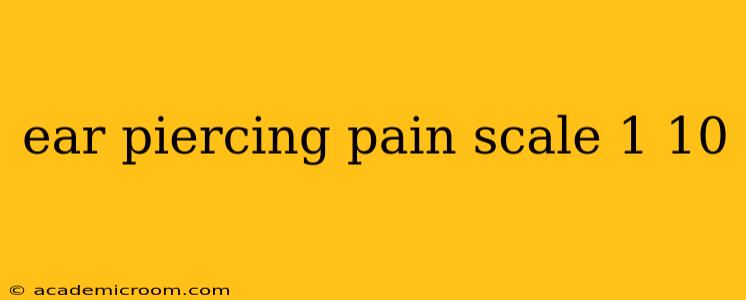Ear Piercing Pain: A 1-10 Scale and What to Expect
Getting your ears pierced is a rite of passage for many, but the anticipation often includes wondering, "How painful is ear piercing on a scale of 1 to 10?" The truth is, the pain experience is highly subjective and depends on several factors. This article will explore the pain associated with ear piercing, addressing common questions and providing insights into what you can expect.
What is the pain of ear piercing on a scale of 1 to 10?
There's no single definitive answer to this. Many describe the sensation as a sharp pinch or quick sting, lasting only a few seconds. On a 1-10 scale (with 10 being the most intense pain), most people rate the pain of ear piercing between a 1 and 3. However, some individuals may experience a slightly higher level of discomfort, perhaps a 4 or 5, especially if they have a low pain tolerance or a sensitive earlobe. The type of piercing, the piercer's technique, and your individual pain sensitivity all play a significant role.
Factors Affecting Ear Piercing Pain
Several elements influence how much an ear piercing hurts:
-
Location of the piercing: Lobe piercings are generally considered the least painful, followed by cartilage piercings (like helix, tragus, or daith). Cartilage piercings involve thicker, denser tissue, making them more likely to cause more prolonged discomfort.
-
Piercer's Technique: An experienced and skilled piercer uses sterile techniques and precise movements, minimizing pain and the risk of complications. A poorly executed piercing can lead to increased pain and discomfort.
-
Individual Pain Tolerance: This is arguably the most significant factor. What one person considers a minor pinch, another might find excruciating.
-
Use of anesthetic: Some piercers offer numbing cream or sprays to help minimize discomfort. However, it's essential to discuss this with your piercer beforehand to ensure it's appropriate for your chosen piercing type.
-
Aftercare: Following proper aftercare instructions meticulously is vital in reducing post-piercing discomfort and promoting faster healing. Improper aftercare can lead to infection, increasing pain and prolonging healing time.
How long does the pain last?
The initial pain from an ear piercing is very brief – only a few seconds. After the piercing is complete, you might experience a dull ache or throbbing sensation for a few hours or even a day or two. This is normal. However, persistent, severe pain, redness, swelling, or discharge may indicate an infection, and you should seek medical attention immediately.
What about cartilage piercings? Are they more painful?
Yes, cartilage piercings tend to be more painful than lobe piercings because cartilage lacks the blood supply and healing capacity of the earlobe. This means they often take longer to heal and can feel more sensitive during the healing process. The pain level can range from a 3 to a 7 on the pain scale, but this is again subjective and depends on individual factors.
Are there any ways to reduce the pain of ear piercing?
-
Choose an experienced piercer: Research piercers with good reviews and a reputation for their sterile practices and techniques.
-
Consider numbing cream: Discuss the option of using a topical anesthetic with your piercer.
-
Relax and breathe deeply: Deep, slow breaths can help you relax and reduce the perception of pain.
-
Distraction techniques: Listening to music or focusing on something else can take your mind off the procedure.
-
Follow aftercare instructions carefully: This helps avoid infections and other complications that can cause increased pain and discomfort.
In conclusion, the pain of an ear piercing is subjective and temporary. While most experience minimal discomfort, understanding the factors influencing pain levels can help you manage expectations and choose the right piercing method for you. Remember to consult with your piercer about any concerns before your appointment.
